Lightning Protection
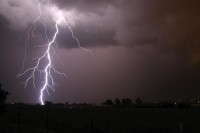 This technical article describes the two kinds of protection against lightning damage in decoder based two or three wire irrigation control systems.
This technical article describes the two kinds of protection against lightning damage in decoder based two or three wire irrigation control systems.
When properly installed, lightning protection in decoder systems will generally be stronger than that found in smaller multi-wire systems. The exception is pedestal-mounted multi-wire, where extensive extra lightning protection components can be housed within the pedestal.
In decoder based systems, there are only two (or three) wires to protect, thus there is more space to fit tough protection components within the controller and in each decoder.
Figure 1 (right) illustrates three decoders interconnected using a 2 wire main cable. Normally the distance between each decoder would be tens or hundreds of metres.
The wires on some decoders do not come out of the other end, but this diagrammatic representation helps understand the principles better.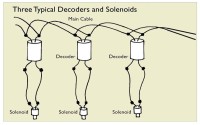
'Main cable' is the common 2 wire path around the site to all the decoders.
The black dots represent waterproof connectors, such as 3M DBY or Connector King equivalents.
When solenoids and decoders coexist in the same valve box, just one set of joints on the solenoid end is needed.
Where lightning strikes, the ground goes up to around 2 million to 4 million volts, with currents in the region of 25 thousand to 100 thousand amps. Although the eye only sees one flash, there are typically 5-10 such strikes in quick succession. No affordable lightning protection scheme will withstand such a direct hit.
The more common event is a voltage surge caused by a nearby strike. In this instance the GROUND goes up to a potential of between 6 thousand to 10 thousand volts. Flashover from the ground onto the wiring usually occurs at a wiring joint where the insulation is at its weakest. If this is a solenoid joint, the currents, typically 10,000A-30,000A, flow through the decoder, destroying it, and travel around the main cables seeking another weak point to go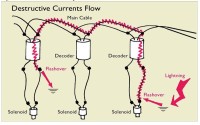 back to a ground which will be at a different potential.
back to a ground which will be at a different potential.
Figure 2 (left) illustrates these current paths.
Damage may also occur when lightning discharges between two oppositely charged storm clouds which are further apart than they are above the ground (Sheet Lightning). In this case, the cables pick up the surge directly, through a phenomenon called induction..
Many manufacturers of decoders rely on the 'bypass' principle, using earth stakes to shunt destructive currents around their decoders. In some form, they use Gas Discharge Tubes (GDTs) which conduct at around 90V - 120V. (Think of them as neon bulbs on steroids!). This voltage is above that used in normal irrigation systems' operation, so they remain 'out of circuit' until a strike. These tubes may be incorporated inside the decoder, or be external. In all cases to be effective, an earth stake must be used to entice the currents up the stake, through the GDT and around the decoder.
Figure 3 (right) illustrates this principle of operation.
Note that the solenoid must be physically near the decoder. Most manufacturers quote a few tens of feet. Where further distances are required, another bypass using GDT and earth stake is required adjacent to the solenoid.
When a manufacturer specifies that earth stakes are only required every 'x' feet or not in every valve box, this is a marketing compromise. Please see the spreadsheet later on in this article to note that voltage differences of several thousand volts may be present over just a few feet.
Incidentally, this bypass technique makes high currents more likely in the main cable, thus putting it and its cable joints at greater risk.
An alternative 'floating' technique relies on the construction of a voltage barrier within the decoder that can withstand typically 10KV (ten thousand volts) and limit currents through the decoder to an amount that can be withstood by the Printed Circuit Board tracks without damage. Because the voltage surge only lasts a few millionths of a second, this technique is practical to use in a decoder. However, this technique is not easy to implement on decoders with advanced features; for example, systems using solenoid current reduction to allow 10's of stations to be active at once. This latter type of decoder relies on the previously mentioned earth stake technique.
Figure 4 (left) illustrates this principle of operation.
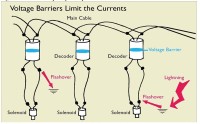 With the floating technique, no earth stakes are needed around the cable path or next to each decoder. Nevertheless, it is important to install just one earth, next to the controller, which must be separate from the building earth system.
With the floating technique, no earth stakes are needed around the cable path or next to each decoder. Nevertheless, it is important to install just one earth, next to the controller, which must be separate from the building earth system.
With this floating technique, it is not necessary to limit the distance between decoder and solenoid. In many installations this can be 1000ft with no significant diminution of lightning protection to either decoder or solenoid.
Peak currents in the main cable are usually smaller than with the earth stakes method, thus it is less likely to be damaged.
An illustration of the extent of voltage gradients:
When an earth stake needs to be connected to the decoder for lightning protection, it is important to keep the stake physically near the decoder. The above chart gives figures for what happens when the stake is remote from the decoder.
The following notes explain the various items in the table. Click on image to view information
The main table indicates the voltage to which the earth rises at a distance from the ground strike of amperage given in cell B1, here illustrated at 50,000 amps.
The yellow figures are feet from the strike; the green are metres from the strike.
The black figures are volts above normal earth potential during the strike.
The magenta figures are the resistivity of the earth (electrical resistance to currents). Typical resistivity figures are given in the small table below the main table.
The blue figures between the black, represent the voltage difference between two points 10 feet (3m) apart.
Thus, if a decoder is earthed though its stake and its solenoid is 10ft away in the direction of the strike, this figure will show the voltage difference between the solenoid and its decoder.
Example:
20,000 Ohms-cm, 1300 ft from the strike of 50,000 amps, the earth will rise to a potential of 377,165 volts above normal.
A solenoid mounted 10ft away from its decoder will see a voltage difference in its surrounding earth of 2,321V compared to that at the decoder.
It is important to note that the above figures are simplified to assume a constant earth resistivity with soil depth. If the upper layer of soil is of a fairly low resistivity (topsoil) and the underlying is high (e.g. bedrock) the voltage stresses are much higher as the lightning currents are concentrated into the upper layer, producing much higher voltage gradients. This means that a strike much further away will produce destructive voltages than with other geologies.
Testing Lightning Protection:
All practical lightning protection schemes are a compromise, where the manufacturer pitches the degree of protection and its cost to the product against the total number of failures encountered over a large number of installations.
To make a decision on where to be on the curve of cost versus number of failures/year, pre-testing of the product is mandatory. Unfortunately, no worldwide test standards are in place that are applicable to the conditions encountered in buried cable irrigation systems. Moreover, the type of equipment necessary to produce a simulated voltage is rare.
The picture depicts a custom-built test generator used by the author.
This produces 8,000-10,000 volts at between 30,000-40,000 amps.
Several iterations of a new controller and decoder design are usually necessary before the product can be released for sale with a satisfactory lightning immunity.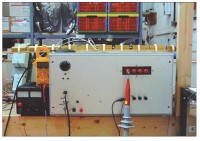
In the past, some manufacturers (thankfully, no longer trading) released decoders with minimal lightning testing, 'hoping for the best'. Because not every site gets a lightning strike, it was not possible to gauge the effectiveness of the designed-in protection until a large number of sites had been equipped and had been operational for a number of years. By this time, any shortcomings could not be rectified practically for the installed base. This historical fact has tainted the perception of many erstwhile users of decoders against their use today.
Conclusions:
With all decoder systems that use earth stakes, the stake MUST be grounded within a few feet of the decoder and solenoid for protection to be effective. Where a decoder has an earth wire coming out, lightning protection for it will be minimal unless a grounded stake is attached.
With the alternative floating lightning protection system, only one earth stake is required at the controller. Additionally, the solenoid can be a great distance from the decoder with no loss of lightning protection. However, this technique can be practical only with simple decoders.
To make a decision on where to be on the compromise of cost versus number of failures/year, pre-testing of the product's lightning protection is mandatory.
About the author: Tony Ware B. Sc., is MD of Tonick Watering Ltd. He can be contacted by email on:tony@tonick.co.uk
Website: www.tonick.co.uk

